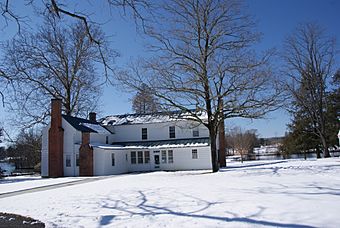Solitude (Blacksburg, Virginia) facts for kids
|
Solitude
|
|

Solitude, February 2012
|
|
| Location | West Campus Drive on Virginia Polytechnic Institute campus, Blacksburg, Virginia |
|---|---|
| Area | 3 acres (1.2 ha) |
| Built | c. 1804 |
| Architectural style | Hall-parlor;Single-pile |
| NRHP reference No. | 89000363 |
Quick facts for kids Significant dates |
|
| Added to NRHP | May 5, 1989 |
Solitude is a very old and important house. It stands on the campus of Virginia Tech in Blacksburg, Virginia. The first part of the house was built around 1802. It was made bigger in 1834 and again in the 1850s. Colonel Robert Preston owned the land around Solitude. He received it from his father, Virginia Governor James Patton Preston. Solitude is more than 200 years old. It is the oldest building on the Virginia Tech campus in Blacksburg.
Contents
What is Solitude?
Solitude is a two-story house. It has an "L" shape and five sections. The house is made of logs and wood. It has a sloped roof. In the mid-1800s, the house was changed. It was given a Greek Revival style. This means it looked like ancient Greek buildings.
Other Buildings at Solitude
There are other important buildings on the property.
- A stone spring house with a log top. A spring house was used to keep food cool.
- An outbuilding built around 1844. In 2019, this building was renamed the Fraction Family House at Solitude. This new name honors the families who lived there. It was home to the largest group of enslaved people on the property. The name also remembers all enslaved people at Solitude.
Solitude's Many Lives
In 1872, the 250-acre Solitude farm became part of Virginia Agricultural and Mechanical College. This college is now Virginia Tech. The farm was mainly used for college farming.
From Home to Hospital
After its owner, Robert Taylor Preston, passed away, the house changed its use. From 1882 to 1886, Solitude was a college infirmary. An infirmary is like a small hospital. It cared for sick students.
Faculty Homes and Clubhouses
After being an infirmary, Solitude and the Fraction Family House became homes for college professors. They were used for faculty housing for 60 years. In the 1940s, Solitude became a clubhouse. It was for World War II veterans. These veterans lived in a trailer park nearby while studying at Virginia Tech. Dances were often held in Solitude's front rooms.
In the 1960s and 1970s, the Hokie Club used Solitude. The Hokie Club supports Virginia Tech sports. The house also still had two apartments for faculty.
Academic Programs and Restoration
In 1974, academic programs started using the building. For a while, Solitude had:
- A human nutrition and food laboratory.
- Interior design studios and offices.
Its last tenant was the Appalachian Studies Program. This program studies the history and culture of the Appalachian region. It has moved back into the building after a big restoration. The Henry H. Wiss Center for Theory and History of Art and Architecture is also in the building.
Solitude was empty for many years. A big restoration project started in July 2010. It cost about $1 million. The project lasted for six months.
Discovering Solitude's Past
Solitude is located in a beautiful park. This park is next to the main Virginia Tech campus. The house was listed on the Virginia Landmarks Register in 1988. It was added to the National Register of Historic Places in 1989. These lists recognize important historic places.
After Solitude was listed, people began studying it more. They researched the house, its land, and the whole area. They wanted to learn more about its history. They also wanted to know what was needed to fix up the house and other buildings.
The Slave Cabin Discovery
This research led to an important discovery. In 2000, a student named Michael Pulice wrote a special paper. He was studying architecture at Virginia Tech. He found that a log outbuilding was not a doctor's office or kitchen, as once thought. Instead, it was a surviving slave cabin and servants' quarters. This means it was a home for enslaved people and servants. Michael Pulice is now a chief architectural historian. He works for the Virginia Department of Historic Resources.



